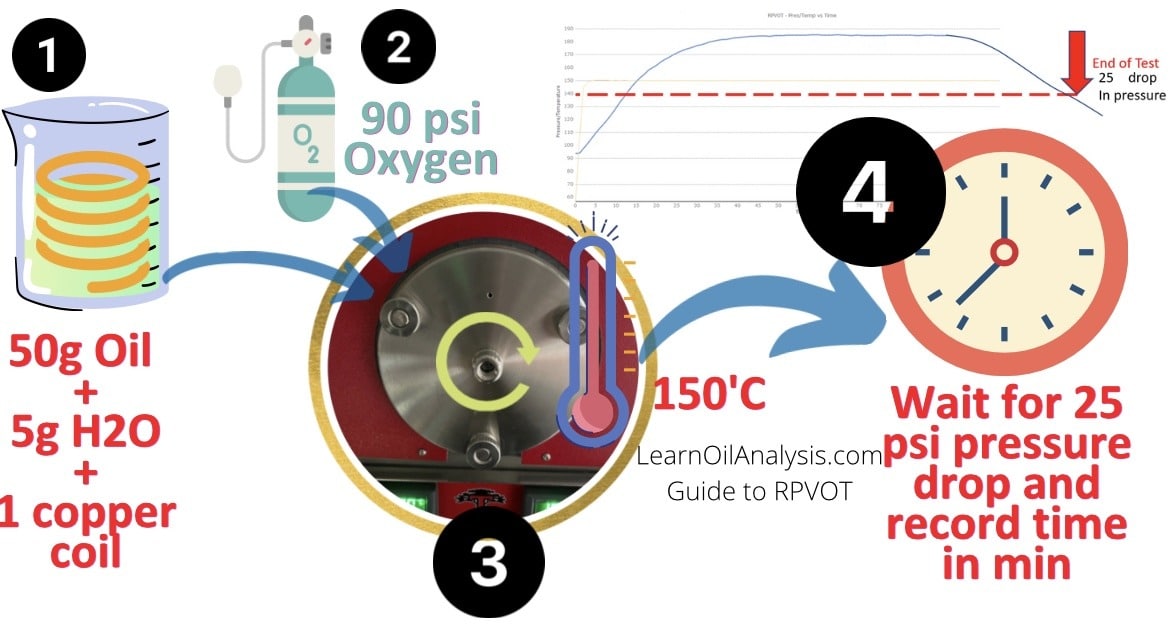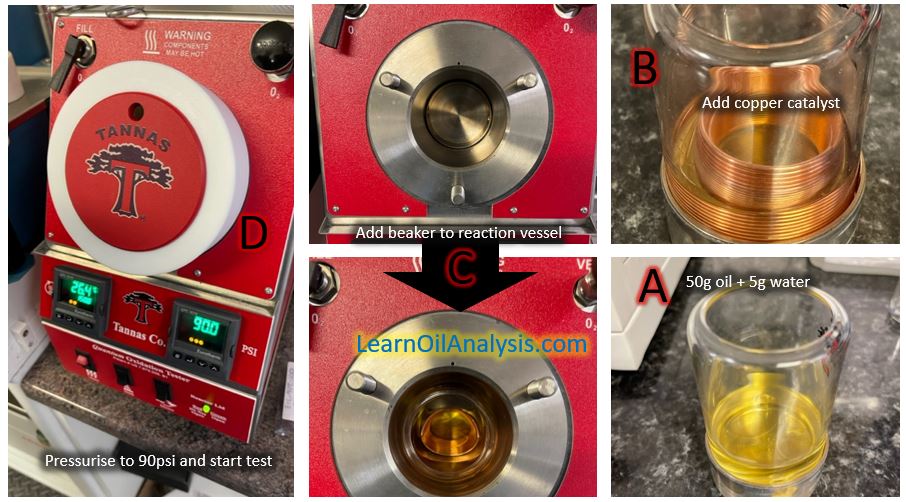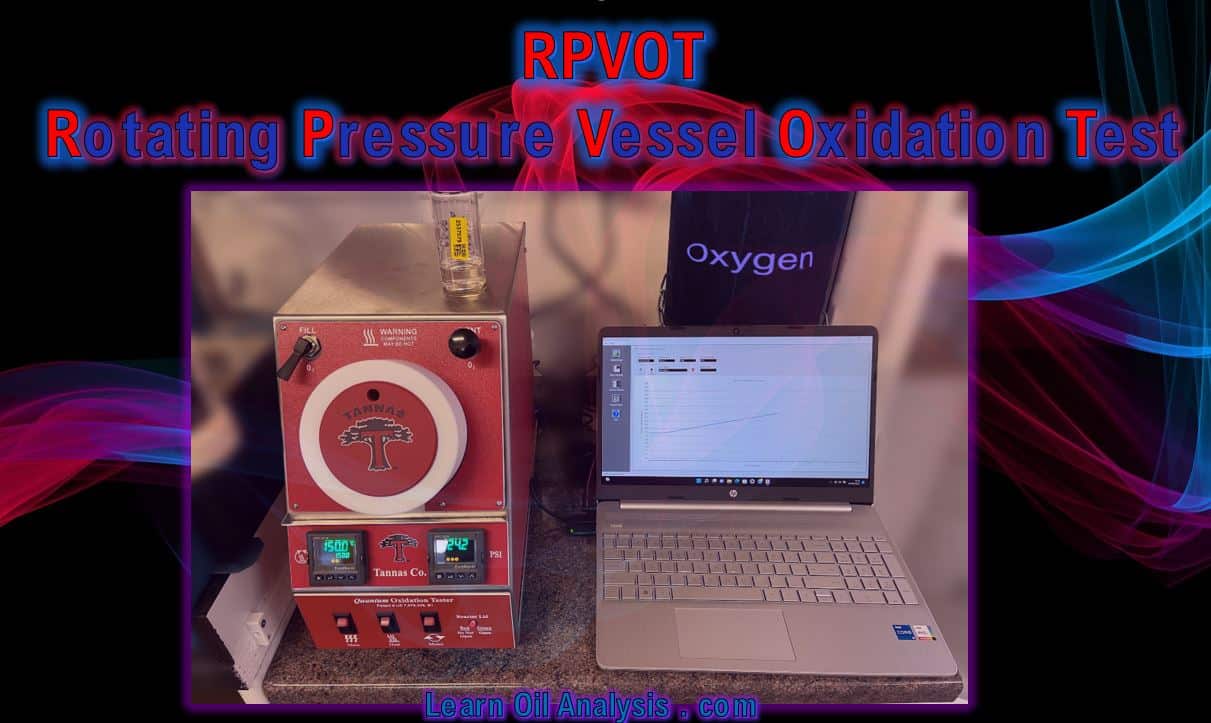What is it?
RPVOT stands for rotating pressure vessel oxidation test. It was formerly RBOT, but the word bomb was replaced with RPVOT with political correctness changes in later years. However, many still say the word R BOT (including me) as it’s easier to say than R P VOT.
The test measures how well an oil resists oxidation. By use of pure oxygen, high pressure, high temperature and water and copper catalysts the traditional oxidation resistance tests of the past, sometimes taking 12 months to get a result could be replaced with a test that took several hours to a day to perform with results measured in minutes.
How does the RPVOT test work?
The test works by:
- A 50g sample of oil is mixed with 5g of deionised water and a copper coil is placed inside the special glass beaker. This is then loaded at a diagonal angle into the pressure vessel.
- The pressure vessel is sealed, flushed with oxygen, and then pressurised with 90 psi of oxygen.
- The whole internal vessel is rotated at a temperature of 150’C, and the pressure is measured inside the vessel every minute. At first, as you heat everything up, the pressure increases and can double in pressure inside from the original 90psi.
- Eventually, the pressure inside stabilises, and the real wait begins. As antioxidants are spent, and the natural resistance of the oil is overcome, some of the oxygen gas joins onto the oil molecules in a process called oxidation. Since oxygen is bonded to the oil and no longer in the gas space above the oil, the pressure exerted by the gas is reduced. Less gas means less pressure, and the pressure begins to drop. By convention, the most popular ASTM method involves measurement until a 25psi drop from the maximum pressure is achieved. However, some labs will, for expediency, agree with the client to stop the test short, e.g. 500 (~8 hours), 1000 (~16 hours) or 1500 (~25 hours) minutes, with premium charges for running a sample “to completion”.
A diagram illustrates these steps below.

Not a fan of diagrams and prefer just pictures, this guide shows you the steps in a little more detail.

How is the RPVOT test used?
RPVOT is used to track the remaining life of the oil with the time in minutes under these accelerated oxidative conditions giving a great indicator of life remaining in the oil. Monitoring this over time can allow power stations, for instance, that have very large oil-filled systems to make plans for oil changes several months in advance and measure the effect of partial changes.
What tests compliment RPVOT?
- RULER/LSV/ anti-oxidant monitoring – RPVOT measures oxidation directly and is still the gold standard test for determining the oxidation resistance of hydraulic and turbine oils. It is still the only oxidation/anti-oxidant measurement that measures BOTH the anti-oxidant and the base oil anti-oxidation properties. It also allows comparison between different oils so you can compare one oil company’s oil over another (hence a few oil companies don’t like this test). However, it does have some limitations. One of these is the reproducibility of +/- 22%, meaning the test is designed for measuring large drops over time rather than very small iterative changes. Hence this means another test called Linear Sweep Voltammetry (often known as a RULER test) to measure the anti-oxidants directly is used, which has better reproducibility than RPVOT, albeit only measuring the anti-oxidants and not the base oil resistance. Many labs offer one or the other, but I recommend both not just because of reproducibility but also because when high concentrations of copper deactivator additives are used in the lubricant to, e.g. protect against copper corrosion, these actually artificially cheat the RPVOT test by coating the catalyst. Hence, you can have RPVOTs of several thousands of minutes in these situations and still be in fairly poor condition oxidation resistance-wise. Some may argue the use of the deactivator is a cheat of the test by the oil companies if they deliberately add very high levels of copper deactivator. Indeed, there are some debates surrounding this in countries outside the UK and less so in the UK. In the UK, the additives used are also known as skin irritants, so many oil companies will keep below the legal threshold so they don’t have to label a product as a skin irritant which avoids this issue in shipping, handling and distribution. Hence, these oils will show limited catalyst deactivation during the test. However, Oil Analysis Laboratories are aware of a few products that still use high levels of deactivators. Thankfully, We have developed a proprietary modification to the RPVOT method to compensate for these scenarios so our customers can still use the test.
- Varnish potential – The RPVOT measures the life remaining in the oil, but sludges and although varnishes suspended in the oil will reduce oxidation resistance, it is not particularly sensitive of the number one hot topic in most industrial lubricant users’ minds of varnish. Hence complement the analysis with a varnish potential test.
Diagnostic significance of RPVOT
The significance of the test is to allow a business to plan for oil changes, which can sometimes take several days to perform and sometimes require months of notice before implementation.
Diagnostic limits
Cautionary alarms begin with a 75% drop in value from reference oil or 75% drop from the first sample if no reference oil is available. Serious or critical limits are a typical 90% drop from ref oil / first sample or a RPVOT of less than 100 minutes remaining. This is a guide only, as customers may start planning for oil changes / consulting their oil supplier for advice much earlier than these limits so a plan can be made for corrective action.
If you would like to find out about RPVOT, or test your oil, or just have a question about oil analysis then get in touch using the contact us button below.


